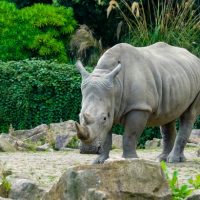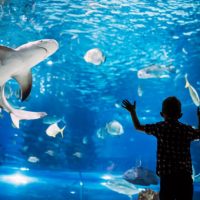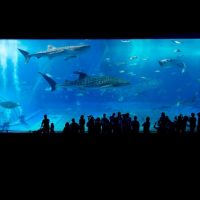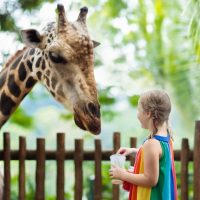Wyoming does not have traditional zoos or aquariums, but it does have places where you can observe and interact with wildlife.
It is a very rural state, with just 587,000 people.
The largest city is Cheyenne, with 64,000.
There are only six cities with more than 11,000 people and only two with more than 50,000.
That could be part of the reason for the lack of traditional zoos.
There are a lot of wild spaces with wild animals, and it is not too hard to spot wildlife as you roam about the state.
The abundance of wildlife probably contributes to people in Wyoming thinking that they don’t have a need for large zoos.
There are still a lot of places to see wildlife in its natural habitat in Wyoming.
Here are some places where you can see and learn about animals.
Best Zoos & Aquariums in Wyoming
Kindness Ranch Animal Sanctuary
The Kindness Ranch Animal Sanctuary is a rescue facility for research and lab animals in a rural area near Hartville in Platte County.
It takes in animals of all kinds from around the country, and most are animals that were part of lab experiments or other research.
This can be anything from cats to horses.
There are yurts onsite where you may spend the night, but reservations are needed.
You may visit year-round, and you may work there as a volunteer.
The facility has 1,000 acres where thousands of animals are cared for.
Animals that are rehabilitated may be adopted, and some live out their lives in the sanctuary.
National Elk Refuge
The National Elk Refuge was created near Jackson Hole in 1912 and continues to flourish today.
The sanctuary is for one of the largest known herds of elk, with a total of almost 25,000 acres.
About 7,500 elk make their way to the refuge each winter.
The elk make their way south toward Yellowstone in the spring and return in late fall.
Horse-drawn sleigh rides are available in winter to help people see the elk herds.
The largest known bison herd in America also winters here, and there are bighorn sheep, pronghorn, mule deer, coyotes, and foxes.
There are roads that you can use to drive to see the wildlife.
Werner Wildlife Museum
The Werner Wildlife Museum is on the Casper College Campus in Casper.
It may be the closest thing to a traditional zoo that Wyoming has.
There are a few hundred animals, as well as various kinds of fish here, and birds.
A children’s center was recently opened, where kids can interact and feed the animals.
Animals, fish, and birds are mostly from Wyoming, but there are animals from around the world here as well.
The museum was started by Herman Werner in 1964 and the college took it over in 1970.
There is also a garden and a picnic area.
Wildlife Mustang Center
The Pryor Mountain Wild Mustang Center is a sanctuary and education center dedicated to wild mustang horses.
It is at Pryor Mountain, and near the town of Lovell.
Admission is free, and you may see and learn about the herd of wild horses that live along the Wyoming and Montana border.
At any given time, you may see dozens of wild horses.
You may visit the area anytime, and there are several roads to take.
There is also an interpretive center and a visitor’s museum, which is also free.
The center opened in 1998.
Wild horses have always been part of the lore of the Cowboy State, and the Pryor Mountain Herd is the most talked about.
Seedskadee Wildlife Refuge
The Seedskadee Wildlife Refuge is a very remote area in southwest Wyoming that is not visited often.
It is not convenient to get to, but this is where you can find the wild part of the wildlife.
There are 26,000 acres of hills and lakes with thousands of animals living normal animal lives.
There are 220 or more species of birds. Moose are fairly common, as well as coyotes, bobcats, coyotes, mule deer, and different species of sheep.
There are lots of trails and you will rarely see anyone else.
Horseback riding is allowed, as well as bicycling in addition to hiking.
The Green River flows through the refuge and that is where you find the most wildlife.
There is no visitors center.
You may find maps at various locations in the refuge, as well as on their website.
Pathfinder National Wildlife Refuge
This is one of the older wildlife refuges in the state, founded in 1909 under the direction of President Theodore Roosevelt.
There are four separate units in close proximity, covering 17,000 acres.
The refuge is in the central part of the state in the high desert plains around the Pedro and Ferris Mountains.
The Platte River runs through the area.
The area is on the routes of migratory patterns of several species of birds.
There are wetlands, mixed grass uplands, sagebrush, and flat habitats.
A large part of this refuge is around the Pathfinder Reservoir.
This is a wildlife refuge in every sense of the word.
It is in a remote area, and there is no hiking allowed except for hunters with seasonal permits.
There is a wildlife observation deck along Highway 220, where there are interpretive panels and an area to observe birds and other wildlife.
There is no formal public access.
Lamar Valley
The Lamar Valley has been called the American Serengeti because of its abundance of wildlife in an unspoiled area.
The area is in the northeast section of Yellowstone National Park.
Start at the northeast entrance to Yellowstone and take the road west.
It is a 29-mile paved road that passes rugged peaks, big valleys, lakes, the Lamar River, and lots of wildlife.
You will see large herds of bison, and big packs of wolves.
The Wolves were reintroduced in the 90s and are doing well.
There are grizzly bears, eagles, coyotes, osprey, deer, pronghorn sheep, badgers, and many more animals.
There are many pullouts along the road where you can stop and watch for wildlife.
Most people do their own tours, but there are guided tours available.
Weidner Wildlife Museum
This may not be everyone’s cup of tea, but the spirit of the Old West lives in Wyoming.
Part of that is collections of animals that have been stuffed, or preserved with taxidermy.
The Weidner Museum is in Rock Springs on a community college campus.
The Weidners donated their collection to the college in 2002.
There are 125 species of wildlife from around the world on display.
There are lions from Africa, bears, and other animals.
Some of these taxidermy examples are very old and give a different view of wildlife than what we see today.
It is a different kind of experience because you see the animals, but they are not alive or moving.
These museums are popular in Wyoming and most are relatively small.
Yellowstone National Park
A popular national park may not be the first place you think of when it comes to wildlife, but Yellowstone National Park is a great place for viewing wildlife.
There are 200 species of animals, such as wolves, bison, bears, eagles, elk, and many more for starters.
The park has the nation’s largest free-range population of bison.
Gray Wolves have been re-introduced and are doing well.
Roads are open year-round, so you can explore wildlife even in winter.
There are also several tour guides offering services.
They usually know the best places and help you see things you probably would not see on your own.
Yellowstone is like a natural zoo, but the animals are free and truly live in their natural habitat.
Even though it is a very popular national park, Yellowstone is a huge area and has more remote areas than other parks.
Hutton Lake Wildlife Refuge
The Hutton Lake Wildlife Refuge near Laramie is a 2,000-acre area that was set aside in 1932.
There have been about 150 species of birds recorded here, and they are plentiful even now.
There are lots of pronghorn sheep, jackrabbits, foxes, weasels, coyotes, prairie dogs, deer, and more.
There are open-water wetlands, upland brush, and grasslands that are great homes for wildlife.
The large lake is an attraction for animals just as it is for humans.
Access is limited from November through February because of the harsh winter conditions that are there.
There are many areas to watch wildlife, as well as roads and trails to explore.
10 Best Zoos & Aquariums in Wyoming – Summary Table
| Zoos & Aquariums | Address |
|---|---|
| Kindness Ranch Animal Sanctuary | 854 WY-270, Hartville, WY 82215, USA |
| National Elk Refuge | 675 E Broadway Ave, Jackson, WY 83001, United States |
| Werner Wildlife Museum | 405 E 15th St, Casper, WY 82601, USA |
| Wildlife Mustang Center | 1106 Road 12 P.O. Box 385. Lovell, WY 82431 |
| Seedskadee Wildlife Refuge | Green River, WY 82935, USA |
| Pathfinder National Wildlife Refuge | Alcova, WY 82620, USA |
| Lamar Valley | NE Entrance Rd, Yellowstone National Park, WY 82190, United States |
| Weidner Wildlife Museum | 2500 College Dr, Rock Springs, WY 82901 |
| Yellowstone National Park | United States |
| Hutton Lake Wildlife Refuge | Laramie, WY 82070, USA |
Wyoming Safety Overview
READ THE FULL REPORT: Wyoming Safety Review
Safety Index:
- OVERALL RISK: MEDIUM
- TRANSPORT & TAXIS RISK: LOW
- PICKPOCKETS RISK: LOW
- NATURAL DISASTERS RISK: HIGH
- MUGGING RISK: LOW
- TERRORISM RISK: LOW
- SCAMS RISK: LOW
- WOMEN TRAVELERS RISK: LOW
Frequently Asked Questions
Where is the best place in Wyoming to observe wildlife?
People in Wyoming say the area around Laramie is the best place to watch wildlife.
It is remote enough that animals feel safe, and it is close enough to Laramie and other towns, to not be too hard to reach.
There is an abundance of wildlife in the Laramie area and a lot of open lands that you can explore.
You can see wildlife with a casual drive in your car, or take a long backpacking trip into the wilderness.
Why are there so few traditional museums or aquariums in Wyoming?
There could be several reasons.
One reason is that it is a very natural state with a sparse population.
It is common to see wildlife in Wyoming, so people may not feel the need to have them in captivity to observe them.
Of course, that limits you to animals that live in that area, but there are a lot of spectacular animals that like the mountains of Wyoming.
What time of day is the best time to see wildlife?
The early morning or late afternoon, when it is starting to get dark, is the best time of day to see wildlife.
Many animals sleep during the day and look for food at night, and that is why you don’t see them often during the day.
Morning seems better than afternoon and the lighting is better then as well.
Weather can also have an influence.
Animals know when a storm is coming, and they can be found just before or just after a storm.
Why is fall the best time of year for animal watching?
Temperatures are cooler, so animals are more likely to be out wandering around looking for food.
There are fewer tourists and less noise, so animals are more relaxed.
They will avoid humans and civilization as much as they can, so when it gets quieter they are easier to see.











